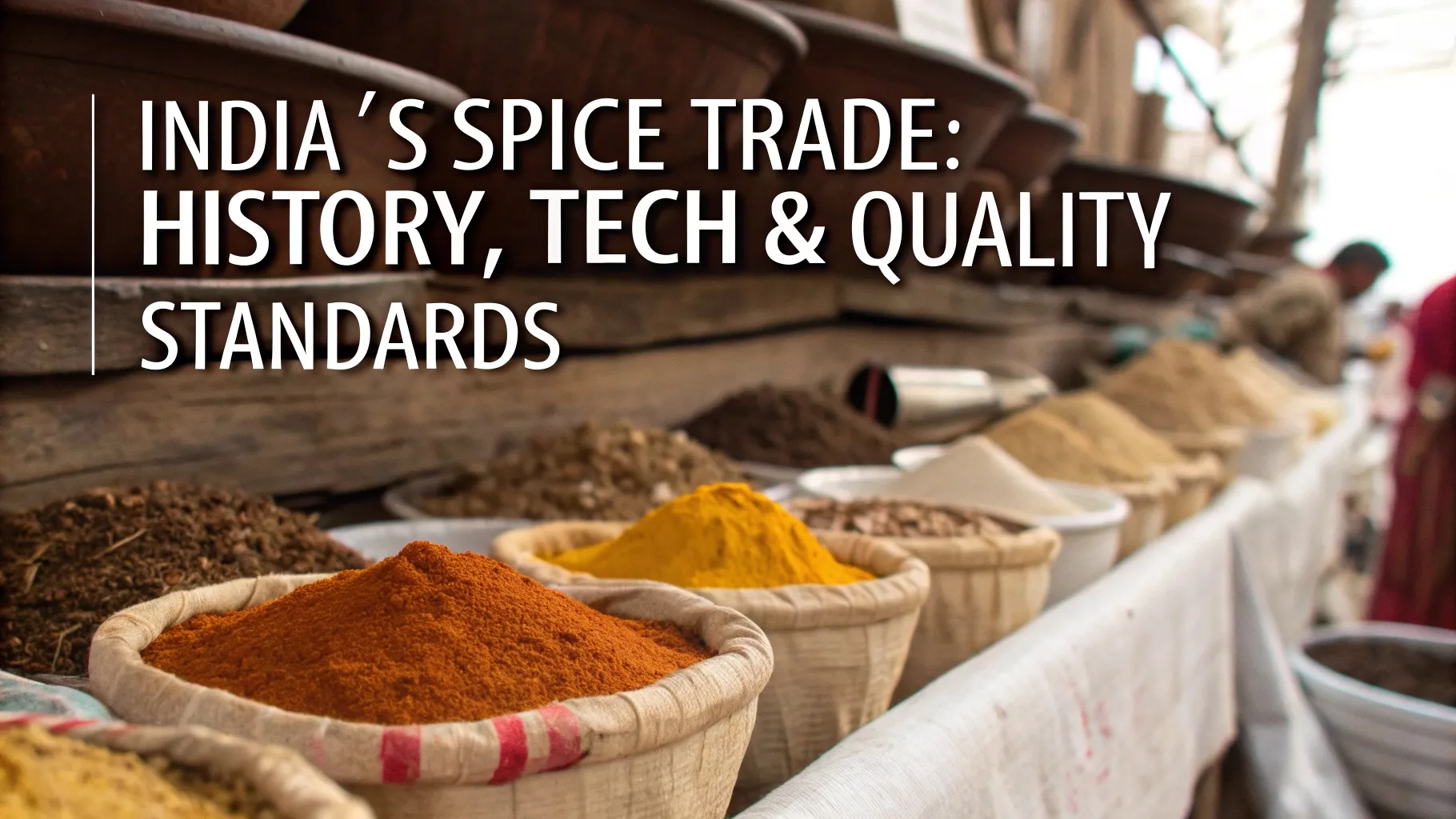India’s Spice Trade Story: A Journey from Ancient Trade to Global Markets
India’s spice trade story began millennia ago, winding through caravan trails and ship-packed harbors. Black pepper, fragrant cardamom, and sweet cinnamon played a role so big that kings sent out envoys and whole fleets just to secure the cargo. Today, that same spirit shines in high-tech processing plants, world-class quality checks, and export pipelines reaching every continent.
The NIIR Handbook tells that long tale and presents it in one handy book. It blends time-tested know-how with the latest food-tech tips, making it invaluable to everyone who touches the spice trade from farmers to factory managers to export officers.
A Rich Heritage: The Story of Indian Spice Trade
For over two thousand years spices built empires and shifted the maps. Port towns like Calicut and Muziris turned into cultural crossroads, welcoming travelers, artists, and scholars along with their pepper sacks. Indian flavors slipped into Egyptian, Greek, and Roman kitchens. Natures perfume also lured European monarchs, launching voyages that opened sea lanes, sparked colonization, and set the wheels of globalization in motion.
The NIIR Handbook brings old techniques back to life, showing how early sorting, sun-drying, and simple oil-pressing still guide the machines we use in big mills today. By mixing this know-how with fresh ideas, the guide nudges new business owners to respect the past while looking forward.
For Complete Details, Get The Book Here.
India Today: Spice Powerhouse and Export Leader
India knows spices—walk through a market, and the scent hits you right away. The country grows about seventy-five percent of all spice types on earth and tops export earnings too.
Buyers in the United States, the UAE, the United Kingdom, and Germany count on Indias most famous crops—black pepper from Kerala, red chili from Andhra, and golden turmeric from Tamil Nadu.
The NIIR book breaks down each state’s weather, harvest time, and shipping routes so readers can see where that strength comes from. It also shows how tiny farmer bags end up in a giant export shipment—and why knowing local land can give a business a global edge.
Supply Chain Reality: From Farm Gate to Shipping Port
India’s spice supply chain leans heavily on small farmers, many tending fields the size of a city yard. After harvest, their crop moves through local mandis, gets graded, sent to a small mill, and waits in coastal sheds until a ship arrives. Throughout the trip, cleaning, testing, sorting, and repackaging happen one after another—each step is a new chance to add clarity, money, and trust.
The NIIR Handbook keeps everyone on the same page. It lays out how to control moisture, stop bugs, and handle spices safely. By digging into truck care, warehouse flow, and shipping red tape, the book gives small and midsize firms tricks to cut waste and save time.
Bridging Tradition and Technology
Old-school methods—sun-dried turmeric, hand-winnowed pepper—still look and smell amazing, and many growers keep them alive. At the same time, cryogenic grinding, pressurized CO? extraction, and smart filling lines sneak into the process. These machines lock in aroma, kill bad microbes, and give cooks the same bright flavor jar after jar.
The NIIR Handbook does a great job of bridging old and new worlds. It tells processors how to keep time-honored methods running while adding modern machines and practices. The payoff is a lineup of high-quality spices that honor tradition yet stand tall on the global market.
Related: How to Build a Sustainable Spice Business with Indian Crops
Advanced Tech: Preserving Flavor, Safety, and Value
Inside its pages, the Handbook explores cutting-edge tools changing the spice business. Take cryogenic grinding. By blasting spices with liquid nitrogen during milling, producers stop heat from stealing aroma—a move that can sell a product. Steam sterilization is another winner; it zaps bacteria in cumin or coriander yet leaves behind the oils that give flavor. For extracting oils and oleoresins, supercritical CO? delivers a strong, solvent-free pull that shoppers and drug-makers are willing to pay extra for.
In every section, the book backs its advice with clear drawings, step-by-step numbers, and tip sheets on where to shop. Because of that, both a brand-new start-up and a veteran miller can spend their budget on the right gear rather than guess.
Quality Assurance: Modern Testing for the Traditional Aroma
Today’s buyers want more than great taste; they demand lab-proof spices. They expect zero Salmonella, tiny pesticide traces, and true volatile oil levels. The NIIR Handbook lays out the must-do tests—from Total Plate Count and aflatoxin checks to GC-MS scans of flavours and debris counts—all done with FSSAI-approved and global methods.
It also shares practical tips for teaming with certified labs or building small in-house setups so companies can control quality, save money, and keep customers happy.
Regulatory Landscape: Standards You Can Trust
India’s food safety structure is strong, resting on several key bodies: FSSAI clears local foods, AGMARK grades farm products, and the Export Inspection Council (EIC) watches shipments. For worldwide sales, firms still follow Codex, HACCP, ISO 22000, and U.S. FDA rules.
The Handbook acts like a translator—it speaks regulatory jargon, guiding businesses through SOPs, checklists, record forms, and training documents that tick both Indian and global boxes. By linking local steps to international standards, it lets exporters move through compliance and certification with clear confidence.
Digital Disruption in Modern Spice Businesses
Spice entrepreneurs today mix age-old know-how with modern tech. Smart farms use sensors to track drying yard humidity, while temperature-controlled trucks send route data straight to logistics apps. Blockchain records a tamper-proof journey from field to shelf, and mobile dashboards keep farmers updated on payments, weather forecasts, and processing times.
Though the NIIR Handbook isn’t pure tech manual, it still points the way: it lists the data every farm needs, shows where automation saves time, and nudges owners to blend old methods with new smart tracking.
Related: Spice Trade: History, Tech & Quality Standards in One Volume
Certifications & Market Trust: How Quality Opens Doors
Buying and selling food is all about trust, and proof builds that trust. Certifications like organic, halal, and kosher crack open new market segments. Awards such as ISO 22000 and BRCGS show that day-to-day operations meet high safety standards. Add blockchain traceability for extra transparency, and suddenly reputations soar.
The Handbook then guides growers step-by-step through audits, record keeping, issuing certified documents, and even handling complaints—key moves for polishing a brand at home and around the globe.
Value-Added Spices: Blends, Health Claims, and Innovation
Basic spice powders are just the beginning. True growth comes from inventive blends—whether handmade curries, gut-friendly seasonings backed by lab tests, or mixes that match foreign tastes. The Handbook lays out a step-by-step R&D road map, ingredient charts, consumer survey findings, and tweaks needed to keep flavor bold while passing safety rules.
Pair that with quality packaging and honest labels, and these blends build brand loyalty and bigger profits, because they talk to shoppers in culturally smart ways.
High-Stakes Export: Navigating Complex Markets
Shipping spices to wealthy countries is not only a freight job, it means tidy papers, lab results, and strict pack tests at every stop. NIIR’s Handbook walks exporters through every piece, from getting an APEDA license to sealing FDA forms and winning shipment green lights. It breaks down EU label quirks, cold-chain routes, shelf-life math, and hygiene checks, giving small and mid-size firms the confidence to grow.
India’s Ecosystem: Research Institutes & Trade Bodies
India’s spice boom rests on solid backers. The Spices Board pushes exports, IISR and ICAR serve fresh R&D tips, and APEDA opens trade doors. This Handbook collects, simplifies, and credits their best ideas, so readers tap cutting-edge science and export help without drowning in heavy reports.
Learning Curve: Training and Entrepreneurial Readiness
Most new traders, students, and small-business owners dive into the spice business with excitement; however, they often lack technical know-how. To bridge this gap, the Handbook highlights hands-on workshops run by NIIR, along with government-backed courses on food safety—all aligned with Qualification Packs (QPs) and MSME support hubs. Through these programs, entrepreneurs gain essential skills such as quality checks, supply-chain management, and export documentation.
Bridging Ecosystem Roles through One Resource
Growers, graders, processors, researchers, and traders have one shared guide: the Handbook on Spices. Its clear charts, steps, and forms keep everyone on the same page, so the whole value chain runs smoothly. That cuts the learning time for new entrepreneurs and stops costly mix-ups, while specialists get a single reference they can trust.
For more information check our project reports
India’s Next Chapter: Innovation, Sustainability, and Premium Branding
India’s spice trade story is shifting from selling bulk to crafting value. The next wave will blend climate-smart farms, AI-run processing, organic seals, and eco-friendly premium brands. The Handbook walks exporters through real-case tips, side-by-side global picks, and step-by-step pushes that turn modern ideas into daily work.
Conclusion: One Book, Endless Spice Possibilities
India’s spice journey spanning centuries, from traders steering wooden boats to scientists in clean rooms, is unmatched in age, scale, and innovation. Now more than ever, the NIIR Handbook on Spices brings together that rich legacy history, lab notes, market insights, and regulatory guidelines into one clear, actionable guide for modern entrepreneurs. Whether you are launching your first batch or reaching shelves around the globe, this book shows you how to stand out and succeed.






